+ データを開く
データを開く
- 基本情報
基本情報
| 登録情報 | データベース: PDB / ID: 7qim | ||||||||||||||||||
|---|---|---|---|---|---|---|---|---|---|---|---|---|---|---|---|---|---|---|---|
| タイトル | In situ structure of nebulin bound to actin filament in skeletal sarcomere | ||||||||||||||||||
 要素 要素 |
| ||||||||||||||||||
 キーワード キーワード | CONTRACTILE PROTEIN / Skeletal muscle / Sarcomere / Thin filament | ||||||||||||||||||
| 機能・相同性 |  機能・相同性情報 機能・相同性情報striated muscle thin filament / skeletal muscle thin filament assembly / stress fiber / actin filament 類似検索 - 分子機能 | ||||||||||||||||||
| 生物種 |  | ||||||||||||||||||
| 手法 | 電子顕微鏡法 / サブトモグラム平均法 / クライオ電子顕微鏡法 / 解像度: 4.5 Å | ||||||||||||||||||
 データ登録者 データ登録者 | Wang, Z. / Grange, M. / Pospich, S. / Wagner, T. / Kho, A.L. / Gautel, M. / Raunser, S. | ||||||||||||||||||
| 資金援助 | European Union, 5件
| ||||||||||||||||||
 引用 引用 |  ジャーナル: Science / 年: 2022 ジャーナル: Science / 年: 2022タイトル: Structures from intact myofibrils reveal mechanism of thin filament regulation through nebulin. 著者: Zhexin Wang / Michael Grange / Sabrina Pospich / Thorsten Wagner / Ay Lin Kho / Mathias Gautel / Stefan Raunser /   要旨: In skeletal muscle, nebulin stabilizes and regulates the length of thin filaments, but the underlying mechanism remains nebulous. In this work, we used cryo-electron tomography and subtomogram ...In skeletal muscle, nebulin stabilizes and regulates the length of thin filaments, but the underlying mechanism remains nebulous. In this work, we used cryo-electron tomography and subtomogram averaging to reveal structures of native nebulin bound to thin filaments within intact sarcomeres. This in situ reconstruction provided high-resolution details of the interaction between nebulin and actin, demonstrating the stabilizing role of nebulin. Myosin bound to the thin filaments exhibited different conformations of the neck domain, highlighting its inherent structural variability in muscle. Unexpectedly, nebulin did not interact with myosin or tropomyosin, but it did interact with a troponin T linker through two potential binding motifs on nebulin, explaining its regulatory role. Our structures support the role of nebulin as a thin filament "molecular ruler" and provide a molecular basis for studying nemaline myopathies. | ||||||||||||||||||
| 履歴 |
|
- 構造の表示
構造の表示
| ムービー |
 ムービービューア ムービービューア |
|---|---|
| 構造ビューア | 分子:  Molmil Molmil Jmol/JSmol Jmol/JSmol |
- ダウンロードとリンク
ダウンロードとリンク
- ダウンロード
ダウンロード
| PDBx/mmCIF形式 |  7qim.cif.gz 7qim.cif.gz | 334.9 KB | 表示 |  PDBx/mmCIF形式 PDBx/mmCIF形式 |
|---|---|---|---|---|
| PDB形式 |  pdb7qim.ent.gz pdb7qim.ent.gz | 285.5 KB | 表示 |  PDB形式 PDB形式 |
| PDBx/mmJSON形式 |  7qim.json.gz 7qim.json.gz | ツリー表示 |  PDBx/mmJSON形式 PDBx/mmJSON形式 | |
| その他 |  その他のダウンロード その他のダウンロード |
-検証レポート
| 文書・要旨 |  7qim_validation.pdf.gz 7qim_validation.pdf.gz | 1.2 MB | 表示 |  wwPDB検証レポート wwPDB検証レポート |
|---|---|---|---|---|
| 文書・詳細版 |  7qim_full_validation.pdf.gz 7qim_full_validation.pdf.gz | 1.2 MB | 表示 | |
| XML形式データ |  7qim_validation.xml.gz 7qim_validation.xml.gz | 64 KB | 表示 | |
| CIF形式データ |  7qim_validation.cif.gz 7qim_validation.cif.gz | 88 KB | 表示 | |
| アーカイブディレクトリ |  https://data.pdbj.org/pub/pdb/validation_reports/qi/7qim https://data.pdbj.org/pub/pdb/validation_reports/qi/7qim ftp://data.pdbj.org/pub/pdb/validation_reports/qi/7qim ftp://data.pdbj.org/pub/pdb/validation_reports/qi/7qim | HTTPS FTP |
-関連構造データ
- リンク
リンク
- 集合体
集合体
| 登録構造単位 | 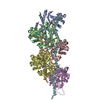
|
|---|---|
| 1 |
|
- 要素
要素
| #1: タンパク質 | 分子量: 42109.973 Da / 分子数: 5 / 由来タイプ: 天然 / 由来: (天然)  #2: タンパク質 | | 分子量: 9188.235 Da / 分子数: 1 / 由来タイプ: 天然 / 由来: (天然)  #3: タンパク質 | | 分子量: 6131.495 Da / 分子数: 1 / 由来タイプ: 天然 / 由来: (天然)  #4: 化合物 | ChemComp-ADP / #5: 化合物 | ChemComp-MG / 研究の焦点であるリガンドがあるか | N | |
|---|
-実験情報
-実験
| 実験 | 手法: 電子顕微鏡法 |
|---|---|
| EM実験 | 試料の集合状態: TISSUE / 3次元再構成法: サブトモグラム平均法 |
- 試料調製
試料調製
| 構成要素 | 名称: Mouse psoas muscle myofibrils / タイプ: ORGANELLE OR CELLULAR COMPONENT / Entity ID: #1-#3 / 由来: NATURAL |
|---|---|
| 由来(天然) | 生物種:  |
| 緩衝液 | pH: 7 |
| 試料 | 包埋: NO / シャドウイング: NO / 染色: NO / 凍結: YES |
| 急速凍結 | 装置: FEI VITROBOT MARK IV / 凍結剤: ETHANE |
- 電子顕微鏡撮影
電子顕微鏡撮影
| 実験機器 |  モデル: Titan Krios / 画像提供: FEI Company |
|---|---|
| 顕微鏡 | モデル: FEI TITAN KRIOS |
| 電子銃 | 電子線源:  FIELD EMISSION GUN / 加速電圧: 300 kV / 照射モード: FLOOD BEAM FIELD EMISSION GUN / 加速電圧: 300 kV / 照射モード: FLOOD BEAM |
| 電子レンズ | モード: BRIGHT FIELD / 倍率(公称値): 81000 X / Calibrated defocus min: 2400 nm / 最大 デフォーカス(補正後): 5000 nm / Cs: 2.7 mm / C2レンズ絞り径: 50 µm |
| 試料ホルダ | 凍結剤: NITROGEN 試料ホルダーモデル: FEI TITAN KRIOS AUTOGRID HOLDER |
| 撮影 | 電子線照射量: 3.4 e/Å2 / 検出モード: COUNTING フィルム・検出器のモデル: GATAN K2 SUMMIT (4k x 4k) |
- 解析
解析
| EMソフトウェア |
| |||||||||||||||
|---|---|---|---|---|---|---|---|---|---|---|---|---|---|---|---|---|
| CTF補正 | タイプ: PHASE FLIPPING AND AMPLITUDE CORRECTION | |||||||||||||||
| 対称性 | 点対称性: C1 (非対称) | |||||||||||||||
| 3次元再構成 | 解像度: 4.5 Å / 解像度の算出法: FSC 0.143 CUT-OFF / 粒子像の数: 141860 / 対称性のタイプ: POINT | |||||||||||||||
| EM volume selection | Num. of tomograms: 48 / Num. of volumes extracted: 183260 | |||||||||||||||
| 原子モデル構築 | B value: 100 / 空間: REAL 詳細: Mg was not refined but copied from the initial model | |||||||||||||||
| 原子モデル構築 | PDB-ID: 5JLH PDB chain-ID: A |
 ムービー
ムービー コントローラー
コントローラー
















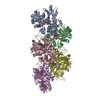
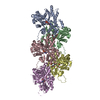
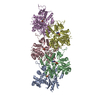
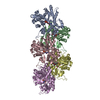
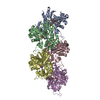

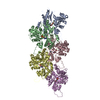

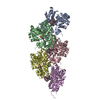

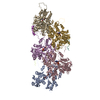
 PDBj
PDBj







